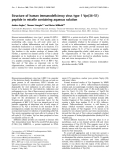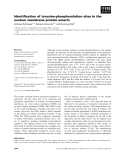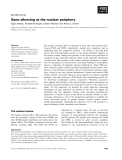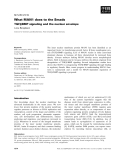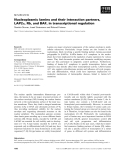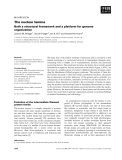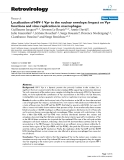
Nuclear envelope
-
Human immunodeficiency virus type 1 protein R (HIV-1 Vpr) promotes nuclear entry of viral nucleic acids in nondividing cells, causes G2 cell cycle arrest and is involved in cellular differentiation and cell death. Vpr subcellular localization is as variable as its functions. It is known, that consistent with its role in nuclear transport, Vpr localizes to the nuclear envelope of human cells. Further, a reported ion channel activity of Vpr is clearly dependent on its localization in or at membranes.
 6p
6p  system191
system191
 01-06-2013
01-06-2013
 33
33
 4
4
 Download
Download
-
The oxygen-evolving photosystem II (PS II) complex of red algae contains four extrinsic proteins of 12 kDa, 20 kDa, 33 kDa and cytc-550, among which the 20 kDa protein is unique in that it is not found in other organisms.We cloned the gene for the 20-kDa protein from a red algaCyanidium caldarium. The gene consists of a leader sequence which can be divided into two parts: one for transfer across the plastid envelope and the other for transfer into thylakoid lumen, indicating that the gene is encoded by the nuclear genome....
 8p
8p  tumor12
tumor12
 20-04-2013
20-04-2013
 46
46
 2
2
 Download
Download
-
Although several proteins undergo tyrosine phosphorylation at the nuclear envelope, we achieved, for the first time, the identification of tyrosine-phos-phorylation sites of a nuclear-membrane protein, emerin, by applying two mass spectrometry-based techniques.
 12p
12p  inspiron33
inspiron33
 25-03-2013
25-03-2013
 38
38
 4
4
 Download
Download
-
The nuclear envelope (NE) is composed of inner and outer nuclear mem-branes (INM and ONM, respectively), nuclear pore complexes and an underlying mesh like supportive structure – the lamina. It has long been known that heterochromatin clusters at the nuclear periphery adjacent to the nuclear lamina, hinting that proteins of the lamina may participate in regulation of gene expression.
 10p
10p  galaxyss3
galaxyss3
 21-03-2013
21-03-2013
 39
39
 3
3
 Download
Download
-
The inner nuclear membrane protein MAN1 has been identified as an important factor in transforming growth factor b⁄bone morphogenic pro-tein (TGFb⁄BMP) signaling. Loss of MAN1 results in three autosomal dominant diseases in humans; all three characterized by increased bone density.
 9p
9p  galaxyss3
galaxyss3
 21-03-2013
21-03-2013
 47
47
 3
3
 Download
Download
-
Lamins are major structural components of the nuclear envelope in multi-cellular eukaryotes. Particularly A-type lamins are also located in the nucleoplasm, likely involving a specific binding partner, lamina-associated polypeptide 2a (LAP2a). LAP2a–lamins A⁄C complexes in the nucleo-plasm have been implicated in the regulation of gene expression by various means.
 12p
12p  galaxyss3
galaxyss3
 21-03-2013
21-03-2013
 35
35
 2
2
 Download
Download
-
The inner face of the nuclear envelope of metazoan cells is covered by a thin lamina consisting of a one-layered network of intermediate filaments inter-connecting with a complex set of transmembrane proteins and chromatin associating factors. The constituent proteins, the lamins, have recently gained tremendous recognition, because mutations in the lamin A gene,
 8p
8p  galaxyss3
galaxyss3
 21-03-2013
21-03-2013
 32
32
 3
3
 Download
Download
-
Basic Cell Biology I. Cytoplasm A. Plasma membrane B. Mitochondria C. Ribosomes D. Endoplasmic reticulum 1. Rough 2. Smooth E. Golgi apparatus F. Lysosomes G. Cytoskeleton II. Nucleus A. Nuclear Envelope B. Chromatin C. Nucleolus D. Nuclear matrix III. Cell division .© 2002 by Bruce Alberts, Alexander Johnson, Julian Lewis, Martin Raff, Keith Roberts, and Peter Walter. .Asymmetrical arrangement of phospholipids in plasma membrane ATP-dependent phospholipid translocase .Molecular Cell Biology, Lodish et al., 4th edition. .Figure 2—1.
 68p
68p  whitedaisy1010
whitedaisy1010
 26-02-2013
26-02-2013
 60
60
 11
11
 Download
Download
-
Tuyển tập các báo cáo nghiên cứu về y học được đăng trên tạp chí y học 'Respiratory Research cung cấp cho các bạn kiến thức về ngành y đề tài: "Localization of HIV-1 Vpr to the nuclear envelope: Impact on Vpr functions and virus replication in macrophages...
 15p
15p  toshiba15
toshiba15
 25-10-2011
25-10-2011
 43
43
 3
3
 Download
Download
CHỦ ĐỀ BẠN MUỐN TÌM








